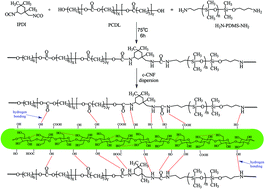Effects of polysiloxanes with different molecular weights on in vitro cytotoxicity and properties of polyurethane/cotton–cellulose nanofiber nanocomposite films†
Abstract
A series of polyurethane/cotton–cellulose nanofiber nanocomposite films are manufactured using amino-terminated polydimethylsiloxane (H2N-PDMS-NH2), polycarbonate diol (PCDL), isophorone diisocyanate (IPDI), and dispersed cotton–cellulose nanofibers (c-CNF). The heat resistance, hydrophobicity, mechanical properties, surface morphology and effect on cells of the film are studied. The results show that as the molecular weight of H2N-PDMS-NH2 increases, the heat resistance and hydrophobicity of the material improve, and when the molecular weight is 4000, its surface free energy reaches 14.9 mJ m−2. This is mainly because an increase in the molecular weight of H2N-PDMS-NH2 changes the chemical structure of the polymer and increases the possibility of low surface energy Si enrichment on the surface. In addition, the cell viability reaches 78.31% in the MTT experiment, which may be related to the biocompatibility of H2N-PDMS-NH2. The relative hemolysis rate of the polymer material to red blood cells is less than 2%, and also shows lower adhesion to platelet cells, which may be related to the hydrophobicity of the surface.



 Please wait while we load your content...
Please wait while we load your content...